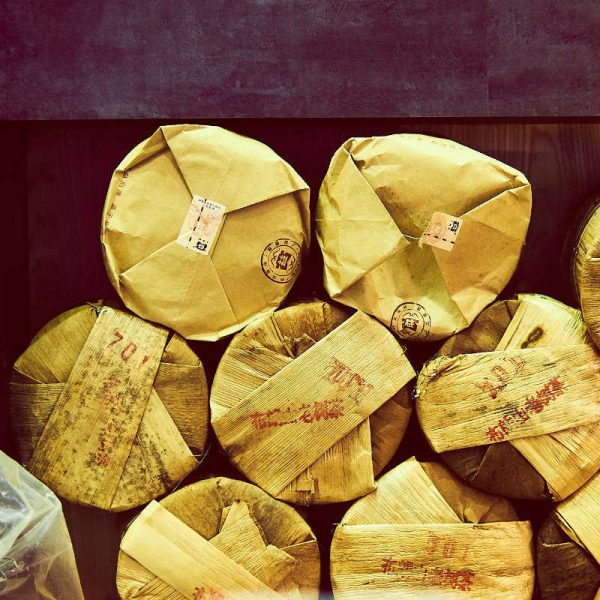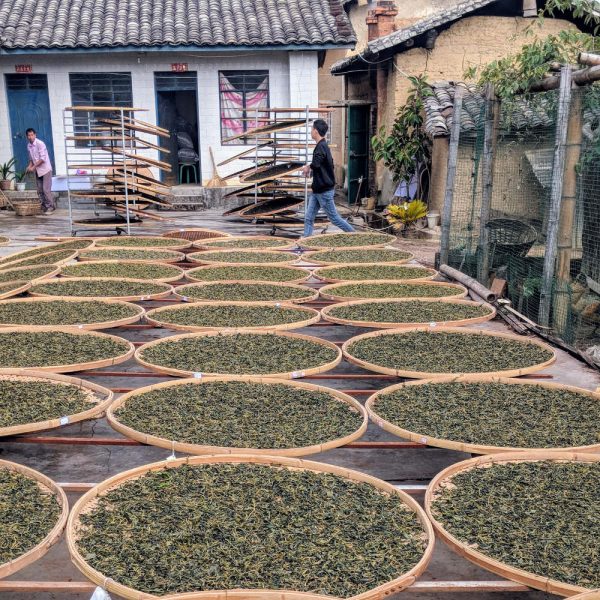Puerh tea in focus
Pu Erh Tea #Mythbusting - What is the hype about?
There are many myths around Puerh tea 普洱茶 – from being good against numerous diseases to helping you lose weight to generally tasting like rotten mold, containing probiotics and so on. At the same time Puerh tea is currently properly the most hyped and complex tea out there. We believe this is for a good reason that’s why we wanted to explain the hype. At least what we understand about it

Puerh tea in focus
What is Puerh tea?
Generally, when talking about Puerh tea, people refer to a type of tea processing that comes foremost out of Yunnan, China and bordering regions like Myanmar. The tea tree, Camellia sinensis originates from this region and already in the 10th century people started pressing the tea in the famous tea cakes. Nowadays you can also find Puerh tea from Vietnam, Taiwan or tea producing places. Pu Erh tea often comes from larger leaf varieties, tea trees, that are withered, baked, rolled and then sun-dried – thus the dark color. The ready product is called Mao-Cha – once it is blended (from several days) and pressed to tea cakes it becomes Pu Erh tea.
This tea is called a Sheng Pu 生普 or Green Pu Erh – the “original form” of Pu Erh tea. The tea cakes are then stored or transported (back in the day by horse, now by plane or train) and under the right weather conditions (high humidity, warm) tea cakes can ripen over time and develop new or more complex flavors. This process takes anything from 1-10 years and changes the liquor of the tea from greenish, yellowish to brownish.
From the 1970s on this ripening process was introduced into the production of Pu Erh tea, the already processed tea “Mao cha” is piled and sprayed with water to speed up the fermentation “渥堆”. Within approximately 4 weeks of post-fermentation you have the finished product, that thing is pressed into tea cakes. This is called Shu Pu 熟普 or Ripen Puerh. The liquor of this tea is dark, almost black.
Taste
Myth #1 - Pu Erh tastes like old rotten mold
As described above, depending on the type of Pu Erh this is not necessarily true. Good Pu Erh – no matter if it’s already post-fermented (“Shu”) or still the raw version (“Sheng”) should have a smooth, sometimes complex taste. Often the “Shu” version is used to cover up bad tea material or made in a bad way, resulting in something not drinkable. We have to admit, that post-fermented Pu Erh can be less accessible, but it should NOT give you a bad feeling in your throat or taste completely off. With enough “Gongfu” from the tea master, Pu Erh tea can be very enjoyable and it is great to discover the ageing, processing and regional differences. If you try our Berlin Flows, it comes from Ailao Mountain, a region that creates a more accessible Puerh with very smooth features and fruity, citrus notes. Stored over time this develops into something more complex, but definitely not close to rotten mold. If you like the fermented taste in other foods, our Formosa Oolong is our recommendation. It has undergone only light 72 hours post-fermentation and makes the tea quite smooth.

Energy
Myth #2 - Pu Erh can cure diseases
Certainly there is something to Pu Erh tea that makes it have a special energy – many come from regions far away from any cities, maybe even grown on old “Gushu” 古樹 trees that have been around for hundreds of years, sometimes grow native. But we try to be very careful about what Pu Erh can really do for your health – if you are sick, always talk with a doctor. Pu Erh tea is a stimulant that contains caffeine and theanine, which both can have stress-reducing effects. Fermented Puerh (“Shu”) or long stored “Sheng” contains very low amount of caffeine due to fermentation, which is generally better for most people and it is easier on the stomach. This is again due to the fermentation and probably also the reason why Pu Erh tea is considered as something good for old people or people with sensitive stomach to drink in Chinese medicine. Any other health claims have not yet been scientifically confirmed. Drink tea in moderation, make sure you know where it comes from (we always test for pesticides!) and enjoy the positive effects. Again for anything else, ask your doctor.
Status
Myth #3 - Pu Erh is only a hype
Yes and no – there is something very decelerating about Pu Erh tea. A tea brick, that is wrapped in paper, brought to you and that will get better over time. You have to practise patience, let the tea sit for a year or two and discover what has changed. While certainly there is a hype around some Pu Erh regions at the moment “Lao Ban Zhang” or “Bing Dao” are some of the famous names, it is also a lot that is good about this attention. Pu Erh tea is one of the most traditional forms of preparing a tea. It is only wrapped in paper, thus minimum waste is created. It is pressed and compressed, so a lot of CO2 can be saved on transporting it. It can be easily stores and gets even better over time. In the end Pu Erh tea is like wine – you do not only need to drink the Bordeaux from 1997, but can discover younger or different regions that taste great. Develop your taste profile and don’t get distracted by “1000 year old trees” or “monks preparing the tea”. Find out what works for you, because if more people start enjoying this kind of tea it would help to reduce the carbon footprint of the tea industry. And hey, it is very delicious!
Ageing
Myth #4 - Pu Erh ripens over time
Yes, but you need the right environment. The perfect conditions for ripening a Sheng Pu Erh are the base for long discussions – so again, it might really depend on your taste first and foremost. That said, there are generally speaking, so called “Dry Storage” (70% humidity, 20°C+) and “Wet storage” (90%+ humidity, 20°C+) that are used. When you live in a very dry place (Below 30-40% humidity) your Puerh tea might not ripen at all, in this case you should just drink it while it’s open. In any other cases, your Puerh will ripen, but it might take longer than under perfect conditions. But hey, it’s nice to wait! We store our Puerh in Taiwan in so called “Dry storage” environment – not super stable but generally with a temperature from 20-30C all year long and a humidity around 70%, with some seasonal peaks. This way we can see the development of our Berlin Flows, and you can enjoy it as well e.g. with our Berlin Flows 2018 edition.